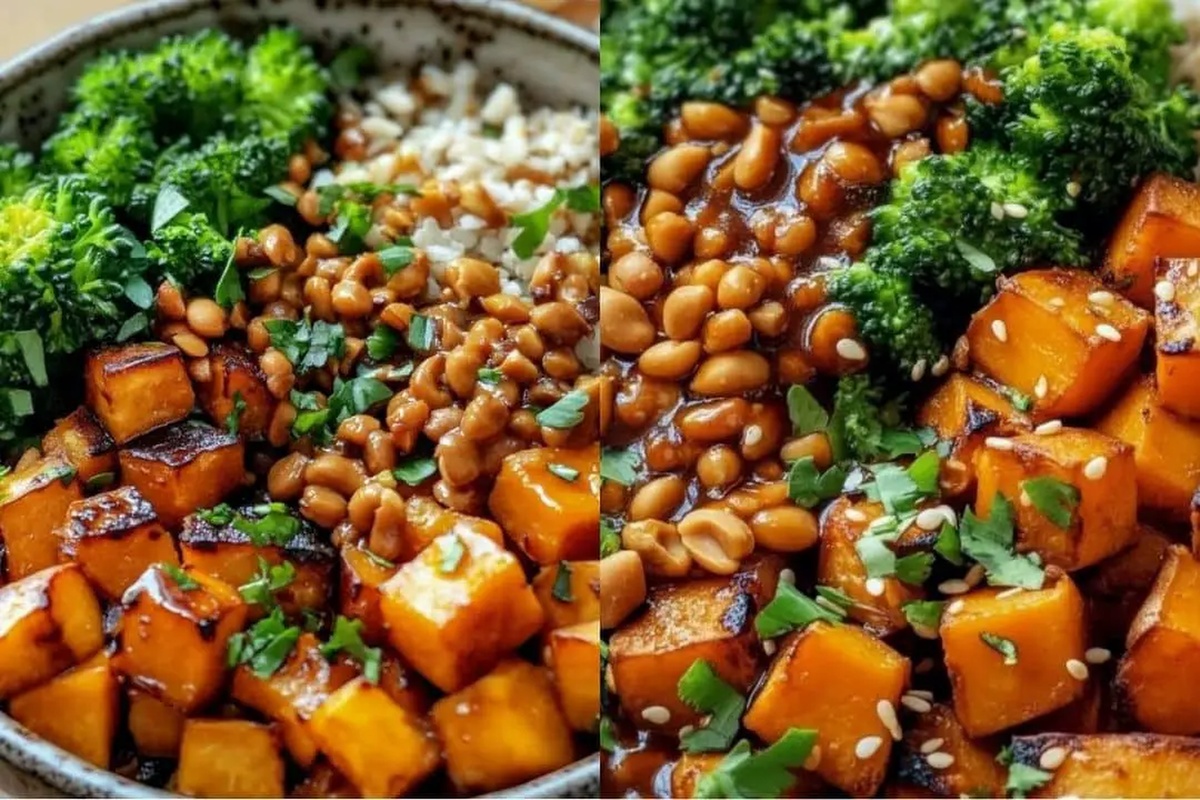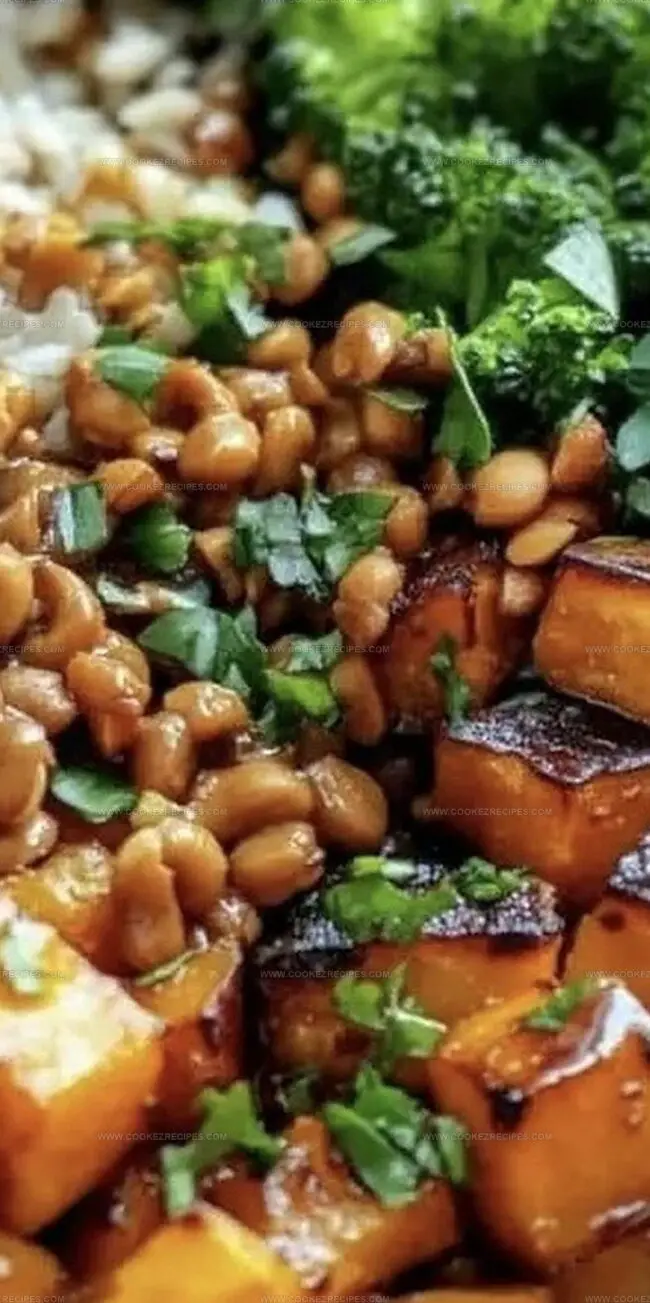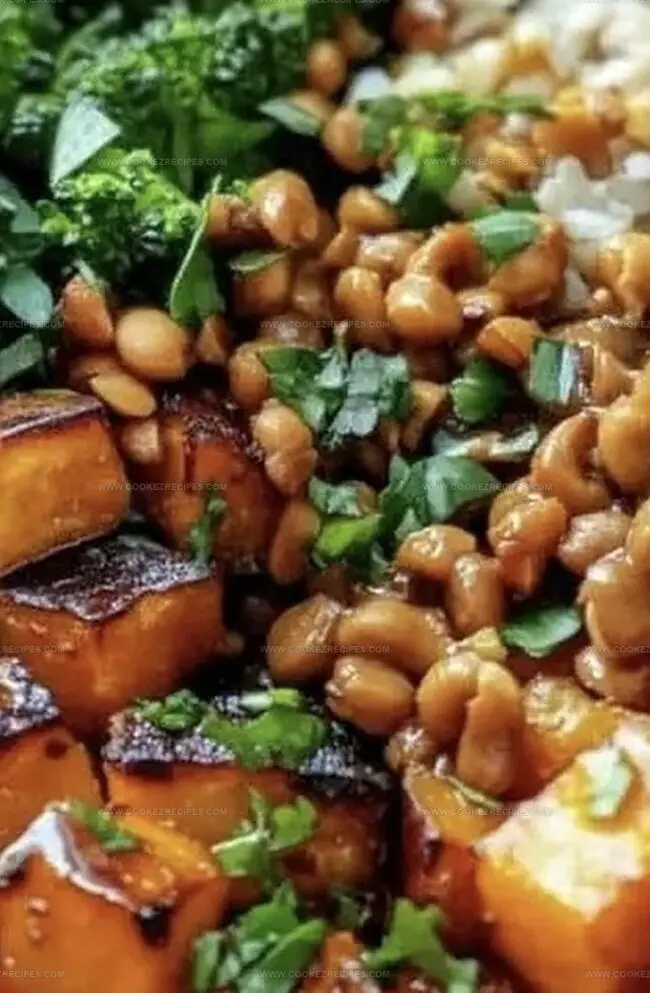Vibrant Thai Peanut Sweet Potato Buddha Bowl Recipe
Sweet potatoes spark joy in this vibrant Thai peanut Buddha bowl that promises a flavor explosion.
Colorful ingredients dance together in a harmonious blend of textures and tastes.
Nutritious vegetables and tender roasted sweet potatoes create a satisfying meal packed with wholesome goodness.
Creamy peanut sauce drizzled over warm, caramelized vegetables adds a delightful twist to your lunch routine.
Crisp greens and crunchy toppings provide perfect contrast to the soft, roasted components.
Quick to assemble and even quicker to devour, this Buddha bowl will become your new midday obsession.
You won’t be able to resist diving into this delectable culinary adventure that combines comfort and nutrition in every single bite.
Cozy, Nutty, and That’s Why This Buddha Bowl Stands Out
Thai Peanut Sweet Potato Bowl Ingredients
Main Ingredients:
Root Vegetables:Grains:Protein Sources:Vegetable Components:
Leafy Greens:Sauce and Seasoning Ingredients:
Sauce Base:Liquid Seasonings:Aromatics:Supporting Ingredients:Garnish:Cooking Ingredients:Buddha Bowl Assembly Steps
Step 1: Roast the Sweet Potatoes with Spicy Flair
Crank up your oven to a toasty 400°F.
Grab your sweet potatoes and toss them with:Spread the seasoned chunks on a baking sheet and roast for 20-25 minutes.
Flip them halfway through to ensure golden, caramelized edges that are crispy on the outside and tender inside.
Step 2: Whip Up the Creamy Peanut Sauce
In a small mixing bowl, blend together these flavor-packed ingredients:Whisk everything until silky smooth.
If the sauce feels too thick, splash in extra water to reach your desired consistency.
Step 3: Build Your Buddha Bowl Base
Layer your favorite grains in the serving bowls – quinoa or rice work perfectly.
Create a colorful landscape by adding:Step 4: Drench in Sauce and Add Crunch
Generously drizzle the peanut sauce over your beautifully assembled bowl.
Sprinkle with:Step 5: Dive into Deliciousness
Mix everything together and enjoy your flavor-packed, nutrient-rich Buddha bowl right away!
Buddha Bowl Tips for Thai Peanut Sweet Potato
Reusing Sweet Potato Buddha Bowl Leftovers
Buddha Bowl Go-With Choices
Perfect Thai Peanut Sweet Potato Buddha Bowl Pairings:Thai Peanut Sweet Potato Buddha Bowl Twists
FAQs
The sauce combines sweet, tangy, and savory flavors from peanut butter, soy sauce, maple syrup, and rice vinegar, creating a complex and delicious dressing that perfectly complements the roasted sweet potatoes.
Yes, this recipe is already vegan-friendly. All ingredients including quinoa, vegetables, peanut sauce, and toppings are plant-based, making it a nutritious and delicious vegan meal.
You can easily increase protein by adding tofu, tempeh, chickpeas, or additional edamame. These plant-based protein sources will enhance the nutritional value and make the bowl more filling.
To make it gluten-free, use tamari instead of regular soy sauce and ensure all other ingredients are certified gluten-free. The recipe’s core ingredients are naturally gluten-free, so it’s easy to adapt.
Print
Thai Peanut Sweet Potato Buddha Bowl Recipe
- Total Time: 40 minutes
- Yield: 4 1x
Description
Hearty Thai peanut sweet potato buddha bowl brings robust flavors dancing across your plate with colorful, nutritious ingredients. Balanced protein, creamy sauce, and roasted vegetables create a satisfying meal you’ll crave again and again.
Ingredients
Protein and Grains:
- 1 cup cooked quinoa or brown rice
- 1/2 cup edamame, shelled
- 1/4 cup chopped roasted peanuts
- 2 tablespoons chopped fresh cilantro
Vegetables and Aromatics:
- 2 medium sweet potatoes, peeled and diced
- 1 cup shredded red cabbage
- 1 cup baby spinach or kale
- 1/2 cup shredded carrots
- 1/2 teaspoon grated fresh ginger
- 1 small garlic clove, minced
Sauce and Seasonings:
- 1/4 cup creamy peanut butter
- 2 tablespoons soy sauce or tamari
- 1 tablespoon sesame oil
- 1 tablespoon maple syrup or honey
- 1 tablespoon rice vinegar
- 1 tablespoon olive oil
- 1 teaspoon smoked paprika
- Salt and pepper, to taste
- 2–3 tablespoons water
Instructions
- Preheat the oven to a high temperature of 400°F (200°C), preparing a baking sheet for the sweet potato transformation.
- Dice sweet potatoes into uniform cubes, ensuring even cooking and caramelization.
- Massage the sweet potato cubes with olive oil, infusing them with smoky paprika, and seasoning generously with salt and pepper.
- Spread the seasoned sweet potatoes across the baking sheet, creating a single layer to promote crisp edges and tender interiors.
- Roast the sweet potatoes for 20-25 minutes, rotating the tray midway to guarantee even browning and maximum flavor development.
- Craft the vibrant Thai peanut sauce by whisking peanut butter, soy sauce, sesame oil, maple syrup, rice vinegar, minced ginger, and crushed garlic into a silky, harmonious blend.
- Adjust the sauce’s consistency by incorporating water, creating a drizzle-friendly texture that coats ingredients beautifully.
- Layer cooked quinoa or rice as a hearty foundation in serving bowls.
- Artfully arrange roasted sweet potatoes, crisp red cabbage, verdant spinach, bright edamame, and delicate shredded carrots atop the grain base.
- Generously cascade the Thai peanut sauce over the colorful ingredients, ensuring each component receives a luxurious coating.
- Sprinkle roasted peanuts and fresh cilantro as the final flourish, adding textural complexity and herbal brightness.
- Serve immediately, encouraging diners to mix the components for a symphonic blend of flavors and textures.
Notes
- Elevate roasting by cutting sweet potatoes uniformly for consistent caramelization and even cooking.
- Customize spice levels by adjusting smoked paprika or adding chili flakes for extra heat.
- Make sauce vegan-friendly by replacing honey with maple syrup and using tamari instead of traditional soy sauce.
- Create meal-prep friendly version by preparing components separately and storing in refrigerator for quick assembly during busy weekdays.
- Prep Time: 15 minutes
- Cook Time: 25 minutes
- Category: Lunch, Dinner
- Method: Roasting
- Cuisine: Thai
Nutrition
- Serving Size: 4
- Calories: 460
- Sugar: 6 g
- Sodium: 360 mg
- Fat: 20 g
- Saturated Fat: 3 g
- Unsaturated Fat: 15 g
- Trans Fat: 0 g
- Carbohydrates: 61 g
- Fiber: 10 g
- Protein: 14 g
- Cholesterol: 0 mg




Katherine Pierce
Recipe Curator & Food Educator
Expertise
Education
Boston University Metropolitan College
Certificate Program in the Culinary Arts
Focus: French and international cuisine techniques, Hands-on culinary training with industry professionals, Food industry insights and operations
Katherine grew up believing every dish has a story. She studied the art of food at Boston University and explored the history behind it. She loves pulling easy recipes from every corner of the world and putting them at your fingertips.
When Katherine’s not writing or testing new flavors, she’s teaching cooking classes, baking colorful mooncakes, or dreaming up new ways to mix old favorites with new twists.